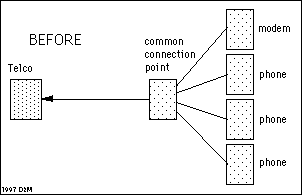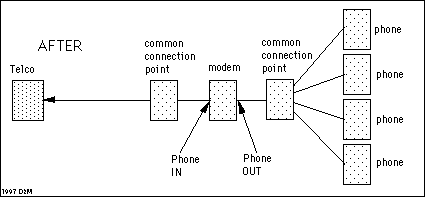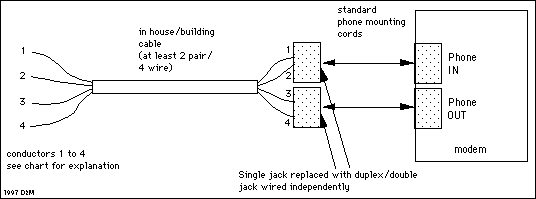Exclusion by Modem (2)
Send a note to D2M
Enjoy this page? Vote
Below are a couple of images depicting the most common wiring arrangement in a line drawing format.Figure 2 illustrates the common parallel wired telephone circuit in a typical dwelling. This situation gives equal access to the telephone line to all devices "plugged" into the circuit be they telephone, modem, fax, etc. If a device requires exclusive use of the line without interuption such as a Mac online or a fax modem, Figure 3 has this handled.

Figure 2
Notice the insertion of the modem into the circuit before the telephones. Modems since the very first have 2 connections for just this purpose. If we use this built in feature data interuptions will be a thing of the past.

Figure 3
There is some modems such as a few built in types that do not have the luxury of the second jack to exclude. These are very fine (less desk clutter) but this can also be solved with another device that detects the use of the phone line and will switch off the down side of the circuit. I have seen these in several catalogs and places such as Radio Shack. Building one of these from scratch has been done here in a pinch but after you find some on sale it is far better to pick one up then, and save a few clams. Unless you have on hand an optoisolator, high Z coil reed switch, a bridge rectifier, couple of 100V caps, and the time. The store bought version comes with an enclosure and that right there is my reason to go this way, not only that some come with a fancy light. Now if that is not the reason to buy one of these, I don't know what it would be. :) I have the worst time with enclosures when building projects, this is the least important part of the project especially if low voltages and frequencies are present. Enuf about my hangups.
We know where to insert our modem into the circuit and now we have to do it.

Figure 4
The diagram above is the idea presented to route the circuit from the outdoors to the modem and back to the common connection point within the building. All with the least amount of fuss and muss.
- A few terms are defined at the bottom of the last page.

-
A few notes:
Caller ID devices are a subject that could take days alone to discuss. If you have one or several of these and have trouble with these I have a few points to ponder. These are slow speed modem type of devices that often depend on the (telephone) line current to operate. The caller ID arrives at your line at a speed of 1200bps in a serial word of varying length. The ITU standard for North America states the information is sent after the first ring and this will be stored at the caller ID device for display. Some modems have just enough circuitry to filter or attenuate the level of the CID info that it may not be valid. If this situation is yours or if you have the enhanced CID-in-use (CID for calls waiting) placing the caller ID unit into the circuit before the modem would be indicated.
Another common problem is the pesky call waiting thing. Here in this part of the world we dial *70 to omit the possiblity of getting another call. The caller is presented with a busy tone (60IPM) and then it is assumed they would call back later. Also we have the option of having the phone company route your call to voice mail (*98) and you can adjust the quantity of rings before this occurs (*94). The codes vary with these options depending on your individual customer group. They allow Centrex service in the residential market here, this would be great to be able to dial 1 or 2 digits to the other line here at the house, but when I think about it when would I ever do that? And for the added cost, not.
Modem dialing strings here again in this part of the world should include *03. This is the code that disables for the duration of the call the pesky message that lets you know the phone company will automatically call-again (*66 ordinarily) if the called number is busy. Once in a while you call your ISP and they are busy, to stop the voice message and let the modem's internal smarts figure the number is busy you should include this code. *70,*03,NXXXXXX is pretty common here, or *70W*03WNXXXXXX if you can support it.
|
If you are uncertain about any of the techniques or ideas presented, please take the time to write. Please be patient in expecting an immediate reply ...Don
|
The counter below sets a cookie to let me know what browser you are using and the OS of choice. This is one way I can best keep my html current for the average Mac'ster. Agreed. |

© 1997 1998 D2M A graduate of Curmudgeon Emeritus.
